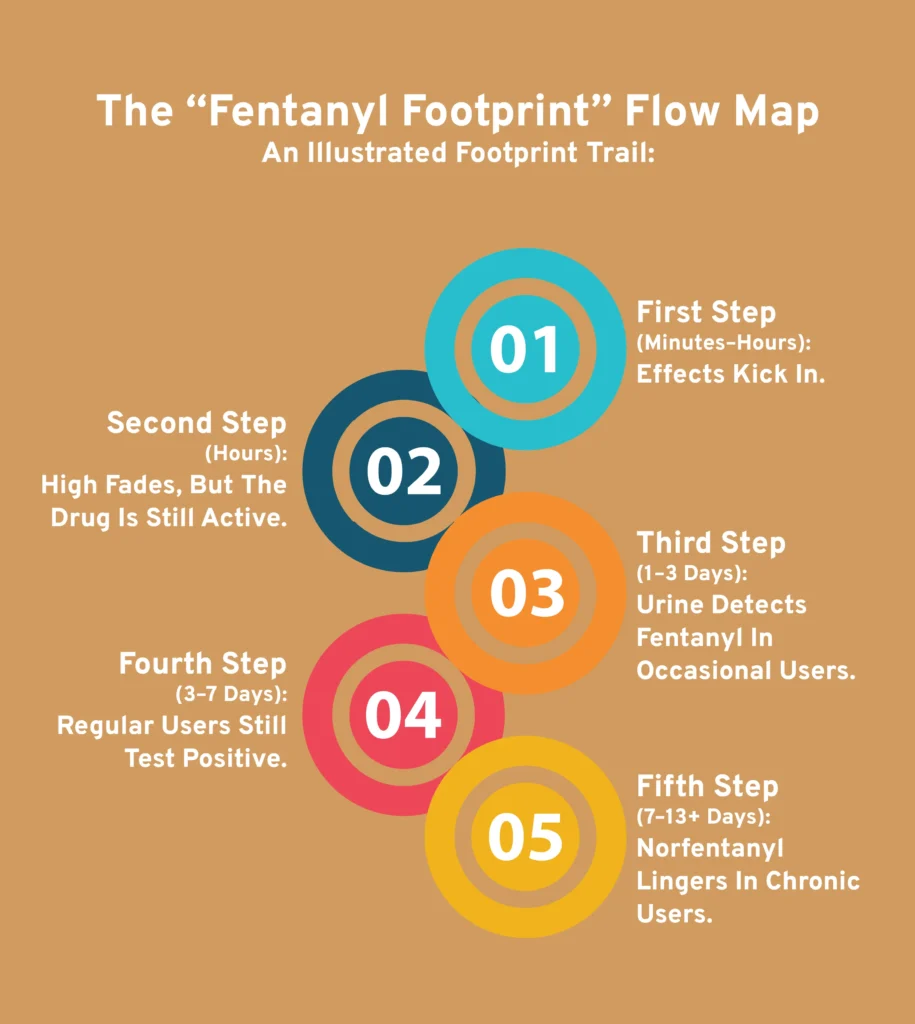It often begins with a late-night Google search, maybe you find yourself typing, “How long does fentanyl stay in urine?” because you’re anxious about an upcoming drug test. Or perhaps you’re a parent, partner, or friend, quietly worrying about someone you love who may be using. For others, it’s a more personal fear: wondering just how long this drug is affecting their body, their health, and their future.
Here’s the reality: asking this question isn’t only about passing a test. It’s often a first signal of something bigger, concern for safety, a desire for answers, or even the very beginning of recovery. Fentanyl isn’t just another pain medication. It’s one of the most powerful opioids ever created, up to 50–100 times stronger than morphine, and it lingers in the body differently than many expect. That’s why timelines for detection can vary widely, from a couple of days to nearly two weeks, depending on use patterns and individual health factors.
This guide will give you more than just numbers. We’ll break down how long fentanyl can be detected in urine, why some people still test positive days after others clear it, and what your next steps could look like if fentanyl has become part of your story. Along the way, you’ll also find helpful insights backed by clinical studies, practical tips for navigating testing, and supportive resources if you or someone you care about may be struggling.
Because at the end of the day, the question “how long does fentanyl stay in urine?” isn’t only about science, it’s about hope, safety, and the possibility of taking back control.
Why Focus on Urine Tests for fentanyl?
When it comes to detecting fentanyl in your system, urine testing remains the most common, reliable, and accessible method. Unlike blood tests, it isn’t invasive. Unlike hair testing, it’s affordable and more practical for everyday use. That’s why you’ll see it used so often in medical detox centers, workplaces, probation programs, and even hospitals when safety is at stake.
But here’s where many online resources fall short: most blogs simply tell you, “fentanyl stays in urine for 1–3 days.” While that’s not entirely wrong, it’s only part of the story. For someone who uses fentanyl occasionally, a 1–3 day detection window may apply. But if you (or someone you care about) use fentanyl more frequently, the timeline can look very different.
In fact, clinical studies, including research published in Drug and Alcohol Dependence have shown that norfentanyl, the primary metabolite your body produces when breaking down fentanyl, can linger far longer. In some cases, it has been detected in urine for 7–13 days or more, particularly among people with chronic or heavy use patterns.
That means two people could take fentanyl on the very same day — and while one might test clear after 48 hours, another could still show positive results a week (or even longer) later.
What Makes Fentanyl Different?
Fentanyl isn’t just another opioid in the same category as oxycodone or morphine. It’s in a league of its own. In fact, fentanyl is estimated to be 50 to 100 times stronger than morphine and about 25–50 times stronger than heroin. That extraordinary potency changes how the body processes and holds onto it, which is why fentanyl detection windows are so different from other opioids.
Here’s what that looks like in practice:
- The effects wear off quickly: While the “high” or pain relief might fade within 30 minutes to 2 hours, the drug doesn’t disappear from your system.
- The half-life is around 7 hours: That means even after seven hours, your body has only eliminated about half of the drug.
- Urine detection lasts much longer: Even if you don’t “feel” fentanyl anymore, its metabolites, especially norfentanyl, can stick around in urine for days or even weeks depending on your metabolism, body fat, and usage history.
Did you know? Fentanyl was first developed back in the 1960s as a powerful surgical anesthetic. But today, it’s at the heart of the opioid overdose crisis in the U.S. and worldwide, largely because of its widespread misuse and the unpredictable strength of illicit versions.
Another layer of danger is that illicit fentanyl is often mixed with other drugs like heroin, cocaine, meth, or even counterfeit prescription pills. This means many people don’t even realize they’ve ingested fentanyl until a urine test reveals it — or worse, until an overdose occurs. Most overdose deaths because of opioids, in recent years, have been linked to fentanyl-laced substances, not intentional fentanyl use alone.
Understanding Fentanyl Detection in Urine
For someone who has only taken fentanyl once or twice, the drug may leave the body fairly quickly. In fact, traces often disappear from urine within 1 to 3 days.
That’s why many online resources stop there. But if you’ve been using fentanyl regularly, the story changes. Moderate or steady use can extend the detection window to 3–7 days, and for people who use heavily or over a long period of time, fentanyl’s byproducts, especially norfentanyl, the metabolite your body produces when breaking it down, can remain in urine for 7–13 days or even longer.
What makes this especially important is that norfentanyl lingers well beyond the “high.” The immediate effects of fentanyl might fade in just a few hours, but the chemical traces don’t vanish nearly as fast. In fact, a clinical study published, focusing on Protracted renal clearance of fentanyl in persons with opioid use disorder found that norfentanyl could be detected more than a week after last use, particularly in people with long-term use patterns. That means even if someone feels sober, their body is still carrying evidence of fentanyl exposure — and in some cases, their system is still working hard to process and recover from it.
For people searching “how long does fentanyl stay in urine,” this isn’t just about passing a test. It’s about understanding how deeply fentanyl embeds itself into the body, how it interacts with metabolism and fat storage, and why recovery often feels harder than expected.
Every person’s timeline looks different, but knowing the ranges can help you or your loved one plan the next step with more clarity and less fear.
Why the Timeline Varies
Several factors influence how long fentanyl stays in urine:
- Frequency of Use → Daily users may have longer detection times.
- Dosage → Higher doses = more drug stored in fat tissue.
- Method of Use → Patches release slowly, while injections move quickly but clear faster.
- Metabolism & Body Fat → Fentanyl is lipophilic (“fat-loving”), so those with higher body fat may hold onto it longer.
- Liver & Kidney Health → These organs filter toxins; compromised function slows clearance.
- Other Medications → Drugs like antifungals, antibiotics, or HIV treatments can interfere with how your liver processes fentanyl.
Key takeaway: There’s no single answer for everyone. What clears in 48 hours for one person may linger for 10 days in another.
Why Urine Tests Detect Fentanyl Long After the High
Many people believe that once the “high” wears off, the drug is gone from their body. But with fentanyl, that’s rarely the case. What makes this opioid particularly tricky is norfentanyl, a metabolite your body produces as it breaks fentanyl down. Unlike the drug itself, norfentanyl can linger in urine long after the noticeable effects fade.
That means you might feel clean and assume the fentanyl is gone, but a urine test could still come back positive days later. This lingering presence is also why the risks don’t necessarily end when the high does. Overdose potential, interactions with other substances, or unexpected side effects can still occur even when you think the drug has left your system.
For people who use fentanyl regularly, detection windows are often much longer. Why? Because norfentanyl, like many drug byproducts, can be stored in fat tissue and released slowly over time. This creates a hidden “reservoir” effect, stretching out how long the drug can be identified in urine and making it harder to predict a clear timeline.
This is one of the reasons fentanyl is so addictive. Even if someone stops using, their body may continue to hold onto metabolites, sometimes for a week or more. And if another opioid or depressant is taken during that time, those stored traces can complicate recovery and increase risks without warning.

Why This Matters Beyond a Test
For many people, the question “how long does fentanyl stay in urine?” isn’t just about passing a drug test, it’s about health, safety, and peace of mind.
One of the biggest concerns is overdose risk. The CDC notes that even small traces of fentanyl, when mixed with alcohol or other opioids, can be deadly. That’s because fentanyl’s metabolites, like norfentanyl, may linger in your system long after the “high” fades.
There’s also the challenge of withdrawal. Once fentanyl starts leaving the body, symptoms like anxiety, sweating, and chills often appear. For regular users, this period can feel overwhelming, which is why understanding the detection timeline is so important.
And finally, there’s the emotional weight. Not knowing how long fentanyl stays in your urine creates stress and uncertainty. Sometimes, simply learning the facts helps restore a sense of control.
Helpful tip: while hydration, good nutrition, and liver/kidney health may support your body, there’s no quick fix to flush out fentanyl. Time and the right support remain the most reliable factors.
Real-Life Contexts Where This Matters
- Workplace Testing → Employers in safety-sensitive industries often use urine testing for fentanyl detection.
- Legal/Probation Cases → Courts rely heavily on urine results to determine compliance with treatment or sobriety programs.
- Medical Treatment → Detox centers use urine results to monitor withdrawal and track recovery progress.
- Family Concerns → Loved ones often turn to urine testing for clarity when behavior raises red flags.
At Drugs Rehab FL, we help families and individuals navigate this confusion — because urine results are only one piece of the recovery puzzle.
Stories the Tests Don’t Tell
Behind every urine test result lies a bigger picture. Families often look to these tests to better understand a loved one’s behavior, while employers use them to ensure safety in the workplace. For doctors, the results provide a clearer roadmap for detox and ongoing treatment.
At the heart of it, though, knowing how long fentanyl stays in urine is about more than timelines or numbers, it’s about safety and recovery. One father shared in a recovery forum that he believed his son was “clean” because he hadn’t seen any signs of drug use.
But when a urine test revealed fentanyl metabolites lingering a week later, it became the wake-up call that helped his family push for treatment. For many, that kind of awareness can mean the difference between continued risk and a chance at healing.
Ready to take the next step toward recovery? You don’t have to face this alone
How long does fentanyl stay in urine after one-time use?
Usually 1–3 days, but it varies.
Can fentanyl stay longer if I use patches?
Yes, Transdermal patches release fentanyl slowly, so urine detection may last longer.
Does drinking water flush fentanyl out faster?
No, Hydration supports your organs, but only time removes fentanyl.
Can nor fentanyl be detected even if fentanyl is gone?
Yes, This metabolite often lasts longer than the drug itself.
What’s the longest it can stay in urine?
In heavy users, up to 13+ days according to clinical studies.


